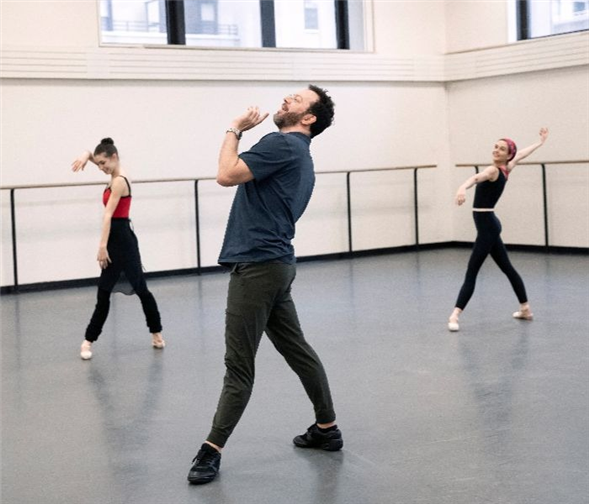Translate Page

The lauded choreographer leaves the classics behind with his latest creation for the company
---
There's an electricity in the air as ten New York City Ballet dancers rehearse a brand-new dance by Alexei Ratmansky. Titled Voices, it's the acclaimed choreographer's first world premiere for the company in three years, and the cast is embracing the challenge of mastering his adventurous movements set to Peter Ablinger's experimental score.
"Every time he comes, I get excited about what he's going to make us do—it's usually things that I've never done before," says principal dancer Sara Mearns about Ratmansky. Voices is the fourth time she's created a role in one of his works and she says "it's a thrill to have him back."
Fellow NYCB principal dancer Adrian Danchig-Waring agrees. "There's a really interesting tension that Alexei brings: He is so invested in steps—the language of classical ballet—but he's also very much a theatre artist," he says. "He creates these dynamic worlds. Voices feels very much like a dance-theatre piece."
One of the busiest and buzziest choreographers of contemporary ballet, the Russian-born Ratmansky, 51, has called New York home since 2009, when he signed on as artist in residence with American Ballet Theatre. But NYCB actually put him in the city's spotlight first, when he created the folk dance-infused Russian Seasons for the company in 2006 while still the artistic director of the Bolshoi Ballet.
All of his half dozen works for NYCB have been striking, bold and original. In 2014, both Mearns and Danchig-Waring were in the original cast of his Pictures at an Exhibition, which conjured a community full of relationships and conflicts out of Mussorgsky's iconic score.
"One of the standout aspects of working on Pictures was how deeply he researched and prepared countless iterations of the dances," Danchig-Waring recalls. "He kept offering up versions, and then he would step back and observe, and either make slight tweaks or present completely new ideas that felt like fully formed dances. He was able to provide us with enough context about the characters we were developing to give the piece a richness greater than the sum of its steps."
For Voices, Ratmansky chose six sections of Ablinger's ongoing song cycle Voices and Piano, which features the recorded voices of an eclectic assortment of artists and activists (Marina Abramovic, Gertrude Stein, Orson Welles, John Cage, Bertolt Brecht and Che Guevara to name a handful) over a spare and jerky piano. All of the figures in the parts Ratmansky picked are women, though save for vocalist and civil rights icon Nina Simone, the rest (avant-garde jazz musician Bonnie Barnett, Iranian poet Forough Farrokhzad, Japanese film actress Setsuko Hara, abstract painter Agnes Martin and Norwegian folk singer Gjendine Slålien) are not exactly household names.
The dancers were surprised when they first heard the score. "For Alexei, this is very out there; he's a man of the classics," says Mearns, who dances a solo set to Barnett's section. "But I think it's a natural evolution, because Alexei always takes chances with us. Even though he knew exactly what steps he wanted to see, it was interesting putting them together with the spoken word. How are they going to connect? How will our movements make sense with what she's saying?"
Ratmansky explained to the soloists that they needed to become the people who are speaking. So Mearns took a deep dive into Barnett's life and music, "listening to her, and reading about what she does."
Danchig-Waring understands why Ratmansky was attracted to this offbeat score. "Alexei said he was drawn to the sonic landscape and the audacity of the composition," he says, noting that Ablinger doesn't impose a musical structure on the voices. Instead, "the way that these artists are speaking about their work and their lives provides all of the rhythmic and melodic impetus."
Based on his previous collaborations with NYCB, Ratmansky was confident the dancers would be open to going in new directions, and he was right. "At this point he knows us well enough to know that we're game for anything he brings," says Danchig-Waring. "We love that process. We love the way that it helps us discover new layers of ourselves."
---
TDF MEMBERS: At press time, discount tickets were available for select NYCB performances. Go here to browse our current offers.
Susan Reiter regularly covers dance for TDF Stages.
Top image: Alexei Ratmansky in rehearsal for Voices at New York City Ballet. Photo by Erin Baiano.